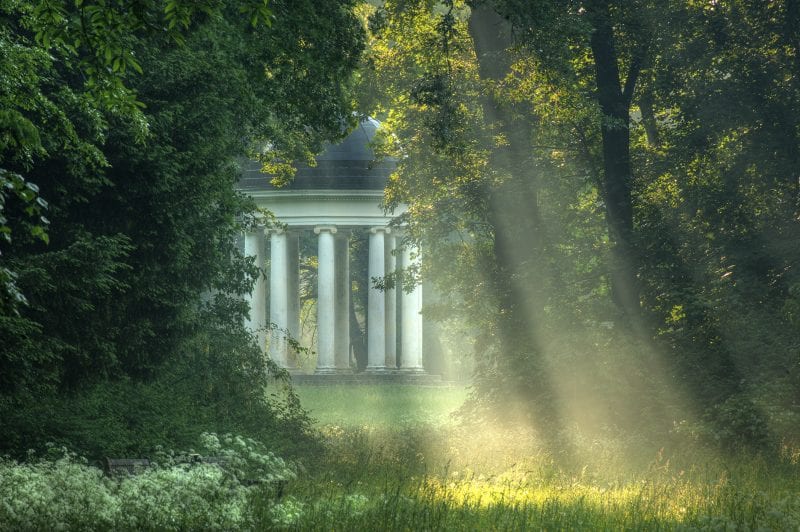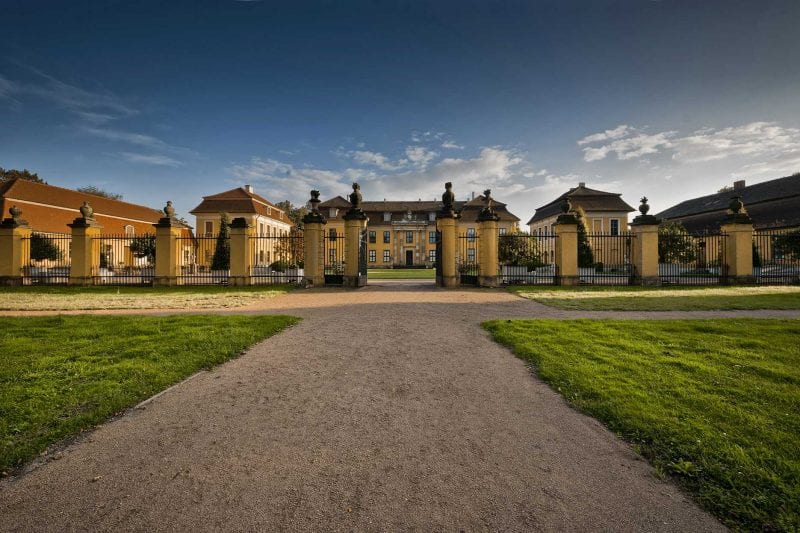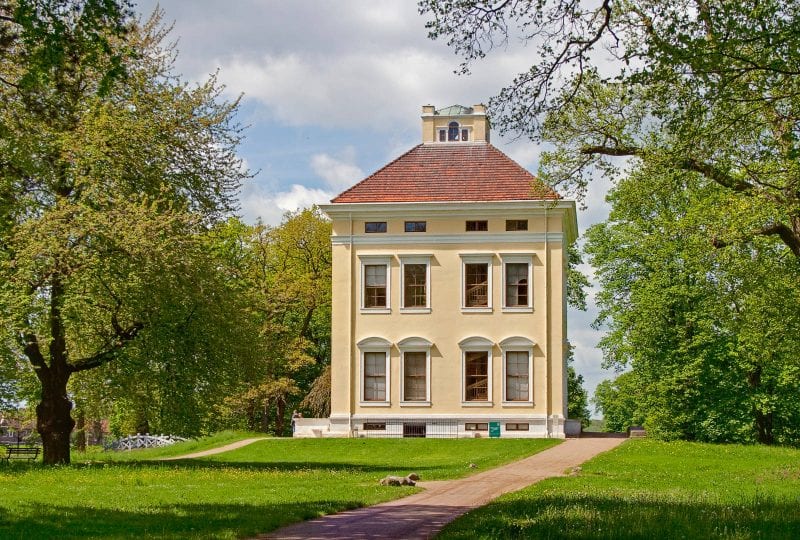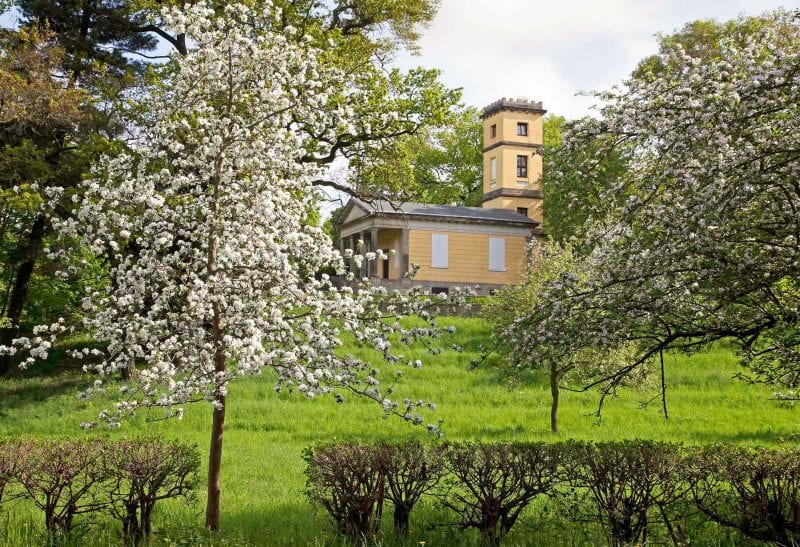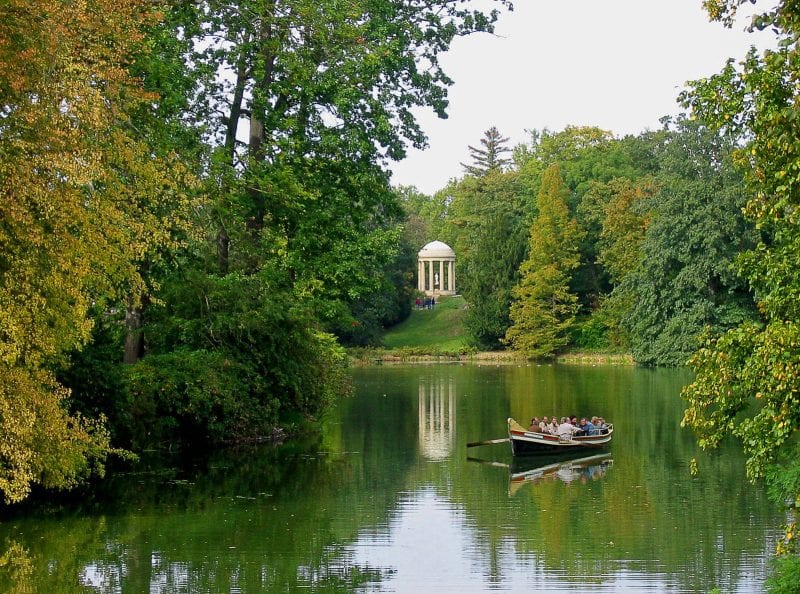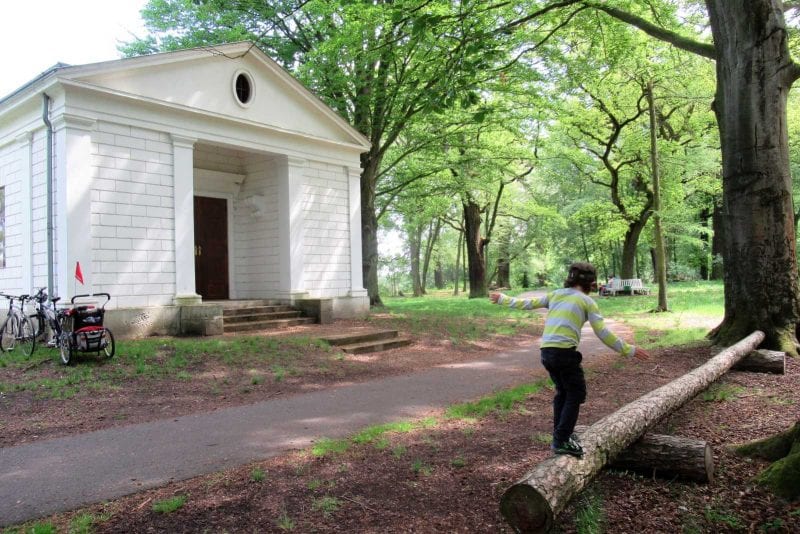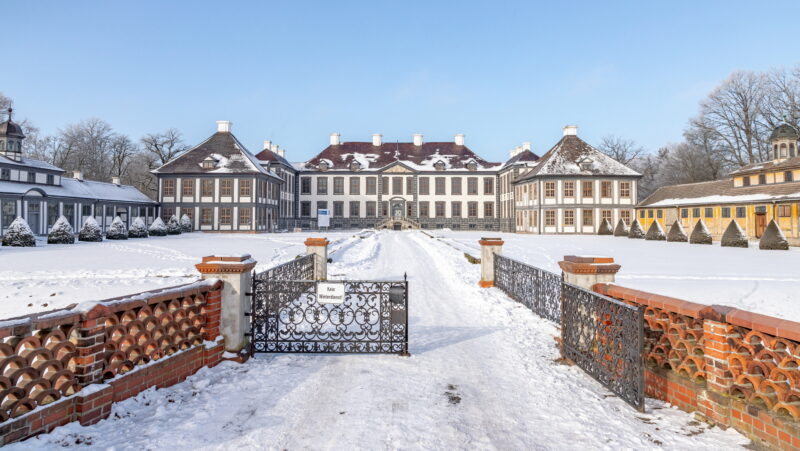Visit Dessau / World Heritage / The Garden Kingdom
Leopold III Friedrich Franz, the enlightened Prince and Duke of Anhalt-Dessau (1740–1817) aimed to combine the “useful with the beautiful”. He set up a programme, unique in Germany, for developing and beautifying the state.
The gardens, castles and works of art can still be admired today. Between Dessau and Wörlitz, there grew up a multitude of parks, gardens and palaces, all linked together by a cultural landscape of meadows and forests. In 2000, the whole landscape shaped by man was added to the UNESCO list of World Heritage Sites.
Find out more at gartenreich.de
Georgium Palace and Park
This park area within Dessau town precincts, consisting of the palace, Georg Garden, Beckerbruch forest and marsh and the wet meadows by the Elbe, is the second-largest landscaped park in the Garden Kingdom.
Beside the park at Wörlitz, this extensive landscaped garden is also the most important in the Garden Kingdom in terms of art history. The park is named after the man who commissioned it, the younger brother of Prince Franz: Prince Johann Georg (1748–1811).
It was laid out by the gardeners Johann Georg Schoch and Johann Friedrich Eyserbeck. The architect Friedrich Wilhelm von Erdmannsdorff designed the neoclassical Georgium Palace and the Flower Garden House, the Orangery and the Fremdenhaus (guest house). The Beckerbruch area was left in its natural state, but embellished with small architectural constructions and monuments, such as the Wallwitzburg, an artificial ruin.
Georgium Palace houses the Anhalt Art Gallery of Dessau, with a rich collection of German and Dutch art, including German Renaissance paintings. Following renovation, it is due to reopen in 2023/24. Until then, a part of the collection can be viewed in the Town History Museum. Special exhibitions are regularly held in the Orangery and the Fremdenhaus.
Mosigkau Palace and Park
Mosigkau Palace and Park, built from 1752 to 1757 as a summer seat for Princess Anna Wilhelmine of Anhalt-Dessau (1715–1780), is one of the few rococo ensembles in Germany that have been preserved largely in their original state.
Anna Wilhelmine’s father, Leopold I of Anhalt-Dessau, made a morganatic marriage with the daughter of a Dessau apothecary, Anna Luise Föhse (1677–1745), out of love. As his extremely well-educated daughter was unable to find a suitable partner, she was provided with two estates and a considerable appanage, which enabled her to build the fascinating rococo ensemble, Mosigkau Palace and Park.
Despite the alterations made after 1780, the original design is still recognisable from the basic structure of the park, the orangery, the Chinese tea-house and the maze.
Inside the palace are 24 rooms with the original furnishings. Important paintings by Dutch masters such as Antonis van Dyck and Peter Paul Rubens, part of the “Orange Inheritance”, can be viewed in the Gallery, displayed Baroque-style as part of a staged collection of art objects.
After the death of the princess in 1780, it was transformed according to her wish into a community for unmarried ladies of the nobility, which existed until 1945. An avenue of old black poplar trees leads northwards to the community cemetery, a contemplative and idyllic corner of Mosigkau park.
Luisium Palace and Park
With its simple yet perfect proportions, the neoclassical Luisium Place, built between 1774 and 1778 in the intimate surroundings of the landscaped garden in the north-east of Dessau, is a masterpiece by the architect Erdmannsdorff.
The palace and park were a gift by Prince Franz of Anhalt-Dessau to his wife Louise, a princess of Brandenburg-Schwedt, on her 30th birthday.
The very exterior of the house, in classical style, lends it an intimate atmosphere unique in the Garden Kingdom. The cube-shaped structure extends up towards the belvedere. All the rooms on the ground floor and first storey are decorated with reliefs and classical-style wall and ceiling paintings. With their fine stucco decorations and wall paintings, the smaller rooms and cabinets on the upper floor are cheerful and elegant.
A long vista through the park looks towards the spire of Jonitzer church, where the tomb of the ducal couple now lies. Interrupting the line of view is the Pegasus Fountain. Not far from this is an artificial grotto and belvedere.
The neogothic Snake House used to serve as a tea house, and today is one of the special holiday homes in the Garden Kingdom. The orangery, now a café and restaurant, mirrors its model in London’s Kew Gardens.
The interweaving of the useful and attractive is evident in the garden. While one part was used for gentle strolls and amusement, the other was used by the court gardeners to grow fruit and vegetables. From the western Wallweg path, you have a view of the buildings of the former Stuterey, or stud farm, where the horses of Prince Franz were bred.
Grosskühnau
Landscape Park
Grosskühnau Landscape Park on the banks of Kühnau Lake is the last major creation of the classical period of landscape design in Dessau-Wörlitz.
The park was begun in 1805 in a riparian forest area with a lake, extensive meadows and a hill providing a vantage point over the lake and countryside.
Kühnau Lake links Grosskühnau Landscape Park with the ensemble consisting of the palace, palace gardens and the church, consecrated in 1830. It lies east on the eastern side of Grosskühnau where the ensemble is located. The church is considered to be the first Romanesque Revival church in Germany.
Grosskühnau Palace was built for Prince Albert of Anhalt-Dessau, a brother of Leopold III Friedrich Franz of Anhalt-Dessau as early as 1780. Today, it is the administrative headquarters of the Dessau-Wörlitz Cultural Foundation.
Wörlitz Park
Contemporaries were thrilled by the sensationally new English-style landscaped garden and the palace, built between 1769 and 1773, which heralded in the period of neoclassical architecture in Germany. Today, Wörlitz Palace can again be visited in its entirety. The original eighteenth-century furnishings have been conserved. It houses a valuable collection of paintings, antique sculptures and English pottery.
The very varied park with its beautiful plants, palaces, temples, bridges, lakes and canals offers visitors innumerable opportunities to relax, enjoy art, experience nature and educate themselves.
What was created more than 200 years ago in Wörlitz is of European stature. It has lost nothing of its magic and enchants its numerous visitors even today.
Sieglitz Hill
The park around Sieglitz Hill covers some 25 hectares and, as intended from the beginning, embodies the image of a “well-ordered wilderness”. The central structure is the restored Solitude.
Cyclists and ramblers are amazed when they suddenly stumble across items of park architecture seemingly in the middle of the forest. “It is the most charming wilderness I know,” wrote the Prince of Ligne, and it was here the poet Ludwig Tieck discovered the “Waldeinsamkeit, die mich erfreut” (“forest solitude that delights me”).
The landscaped garden that Prince Franz also ordered to be created for medicinal cures is a uniquely special area of the Garden Kingdom owing to its natural state. The central structure is the “Solitude”, which thanks to huge civic commitment has now been restored and is open to the public. The small, classical-style house takes the form of a Roman temple.
The park lies on a rise, safe from flooding. The paths to Sieglitz Hill are bordered by gateways. Coming from the west, you arrive at the Baroque-style Dessau Gate, coming from the east at the neo-Gothic Burgtor (Castle Gate), also known as Walltor (Rampart Gate). The classical South Gate is modelled on Italian architectural styles.
Oranienbaum Palace and Park
The name by which Oranienbaum is known today comes from Henriette Catharina of Orange-Nassau, the wife of Prince Johann Georg II of Anhalt-Dessau.
In 1773, he gave her the village of Nischwitz as a wedding gift. Henriette Catharina commissioned the Dutch architect Cornelis Ryckwaert to plan the ensemble. He worked on it until the end of his life, and his son continued the work.
The palace, flanked by outbuildings, faces the town and market square with its wrought-iron orange tree, symbolising the House of Orange. Similarly, the town seems to open up towards the palace. An almost democratic impression, but whatever the case, very Dutch in appearance.
The Anglo-Chinese Garden with its Chinese tea house and five-storey pagoda was built on the instructions of Prince Franz. The 176-metre-long orangery, completed in 1818, is the longest in Europe.
Lavish interior decoration with precious leather wall coverings, faience and paintings create an impression of splendour, to which rooms such as the Summer Dining Hall with its historic tiles, the Porcelain Gallery with its unique leather wall coverings and the Mirror Crystal Hall still contribute today.
The palace houses a permanent exhibition on the history of hunting in Anhalt-Dessau and, in the Kavalier Pavilion, an exhibition on the once flourishing tobacco production in Oranienbaum. There was a long tradition of tobacco growing in Anhalt. The first farmer in Oranienbaum was granted the privilege of growing tobacco in the year 1693.
Information
Addresses
Georgium Palace and Park
Puschkinallee 100, 06846 Dessau-Roßlau
Public transport:
Bus lines 11, 12, 17, Stop Puschkinallee / Tierpark
Mosigkau Palace and Park
Knobelsdorffallee 2-3, 06847 Dessau-Roßlau
Phone +49 340 50255721
schloss-mosigkau@gartenreich.de
Public transport:
Bus line 16, Stop Schloss Mosigkau
Dessau-Mosigkau train station (1,2 km by foot)
Luisium Palace and Park
Schloss Luisium, 06844 Dessau-Roßlau
Phone +49 340 218370
schloss-luisium@gartenreich.de
Public transport:
Dessau-Wörlitz railway, Waldersee station (2 km by foot)
Bus lines 13, 304, Stop Neue Schule / Luisium
Wörlitz Gardens
Schloss Wörlitz, 06785 Oranienbaum-Wörlitz
Phone +49 34905 409-0
schloss-woerlitz@gartenreich.de
Public transport:
Dessau-Wörlitz railway, Wörlitz station
(1 km by foot)
Bus line 304, Stop Neue Reihe
Oranienbaum Palace and Park
Schloßstraße 9a, 06785 Oranienbaum-Wörlitz
Phone +49 34904 20259
schloss-oranienbaum@gartenreich.de
Public transport:
Dessau-Wörlitz railway, Oranienbaum station (1 km by foot)
Bus line 310, Stop Bahnhof
Opening hours
Palaces Luisium, Mosigkau and Oranienbaum, Gothic House:
| 22.03.* — 30.04. 01.10. — 02.11. | Sat, Sun, Public Holidays | 10.00 a. m. — 5.00 p. m. |
| 01.05. — 30.09. | Tue — Sun, Public Holidays | 10.00 a. m. — 5.00 p. m. |
*Due to renovation works, Mosigkau Palace opens on April 5th, 2025.
Palace Georgium:
The Anhalt Art Gallery in Palace Georgium is open every day vom 10.00 a. m. to 6.00 p. m. except for Tuesdays.
Wörlitz Palace and “Stone” Island:
| 22.03. — 30.04. 01.10. — 02.11. | Tue — Sun, Public Holidays | 10.00 a. m. — 5.00 p. m. |
| 01.05. — 30.09. | Tue — Thu, Sun, Public Holidays Fri, Sat | 10.00 a. m. — 5.00 p. m. 10.00 a. m. — 6.00 p. m. |
The house of the Princess:
| 01.01. — 28.02. 03.11. — 30.11. | Wed — Mon | 11.00 a. m. — 4.00 p. m. |
| 27.05. — 30.09. | Tue — Thu, Sun, Public Holidays Fri, Sat | 10.00 a. m. — 5.00 p. m. 10.00 a. m. — 6.00 p. m. |
| 01.10. — 02.11. | Tue — Sun, Public Holidays | 10.00 a. m. — 4.00 a. m. |
Closed due to exhibition renovation from 01.03. to 27.05.2025
The parks are freely open to the public all year round.
Prices
| Single ticket: | 9 € |
| Reduced ticket: | 7 € |
| Guided tours: | The entrance fee includes a guided tour of the castle. |
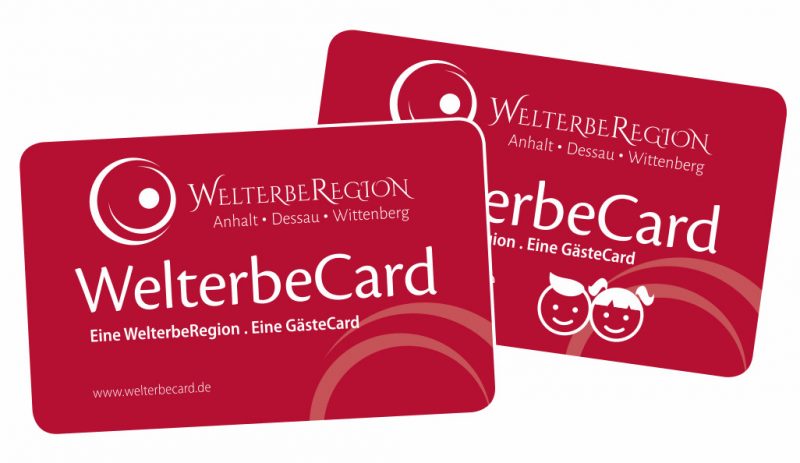
World Heritage Card
Discover the Garden Kingdom with all its castles and parks at a special price!
With this guest card you pay only once and can use far more than 100 services from four UNESCO World Heritage Sites from art, culture, nature, leisure and gastronomy.
As your time permits, either in 24 hours or on three freely selectable days within the validity.
Further information at World Heritage Card.
